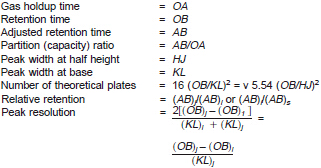5. Gas Chromatographic Data
5.1 A Chromatogram is a plot of detector response against time or effluent volume. Idealized chromatograms obtained with differential and integral detectors for an unretained substance and one other component are shown in Fig. 1.
5.2 The definitions in this paragraph apply to chromatograms obtained directly by means of differential detectors or by differentiating the records obtained by means of integral detectors. The Baseline is the portion of the chromatogram recording the detector response in the absence of solute or solvent emerging from the column. A Peak is the portion of the chromatogram recording the detector response while a single component is eluted from the column. If two or more sample components emerge together, they appear as a single peak. The Peak Base, CD in Fig. 1, is an interpolation of the baseline between the extremities of the peak. The area enclosed between the peak and the peak base, CHFEGJD in Fig. 1, is the Peak Area. The dimension BE from the peak maximum to the peak base measured in the direction of detector response is the Peak Height. Retention dimensions parallel to the baseline are termed as the peak widths. The retention dimension of a line parallel to the peak base bisecting the peak height and terminating at the inflexion points FG of the tangents drawn to the inflection points (= 60.7 % of peak height) is the Peak Width at Inflection Points, wi. The retention dimension of a line parallel to the peak base drawn to 50 % of the peak height and terminating at the sides HJ of the peak is the Peak Width at Half Height, wh. The retention dimension of the segment of the peak base KL intercepted by the tangents drawn to the inflection points on both sides of the peak is the Peak Width at Base or Base Width, wb.
5.3 The following definitions apply to chromatograms obtained with integral detectors, or by integration of the records obtained by means of differential detectors. As sample components pass through the detector the baseline is displaced cumulatively. The change in baseline position as a single sample component is eluted is a Step. The difference between straight line extensions of the baselines on both sides of the step, measured in the direction of detector response, is the Step Height, NM.
6. Retention Parameters
6.1 Retention parameters are listed in Table 1. The interrelations shown apply only to gas elution chromatography columns operated under constant conditions and for which the partition coefficients are independent of concentration. Fig. 1 can be used to illustrate some of these parameters:

Subscripts i, j, and s refer to any earlier peak, any later peak, and a reference peak, respectively.
7. Presentation of Isothermal Retention Data
7.1 Retention values should be reported in a form that can be applied for a specific stationary phase composition in different apparatus and for different conditions of column length, diameter, and inlet and outlet pressures, and for different carrier gases and flow rate. When the solid support is inert, its particle-size range and distribution, and (within limits) the amount and mode of deposition of the liquid phase, may be varied also. While the solid support is commonly assumed to be inert, often this is not so. The physical disposition of the liquid phase may also affect retention values (1). Consequently, all components of the column packing and the procedure for combining them must be fully specified to enable other workers to prepare identical compositions.
7.2 Retention in gas-liquid chromatography can be expressed on an absolute basis in terms of the partition coefficient or specific retention volume of a substance (tacitly assuming an inert solid support). Relative retentions are more conveniently determined, however, and they should be expressed relative to a substance which is easily available and emerges relatively close to the substance of interest.
7.3 Retention index is another retention parameter. It is defined relative to the retention of n-alkanes, and represents the number of carbon atoms, multiplied by 100, in a hypothetical n-alkane that would have an identical retention.



